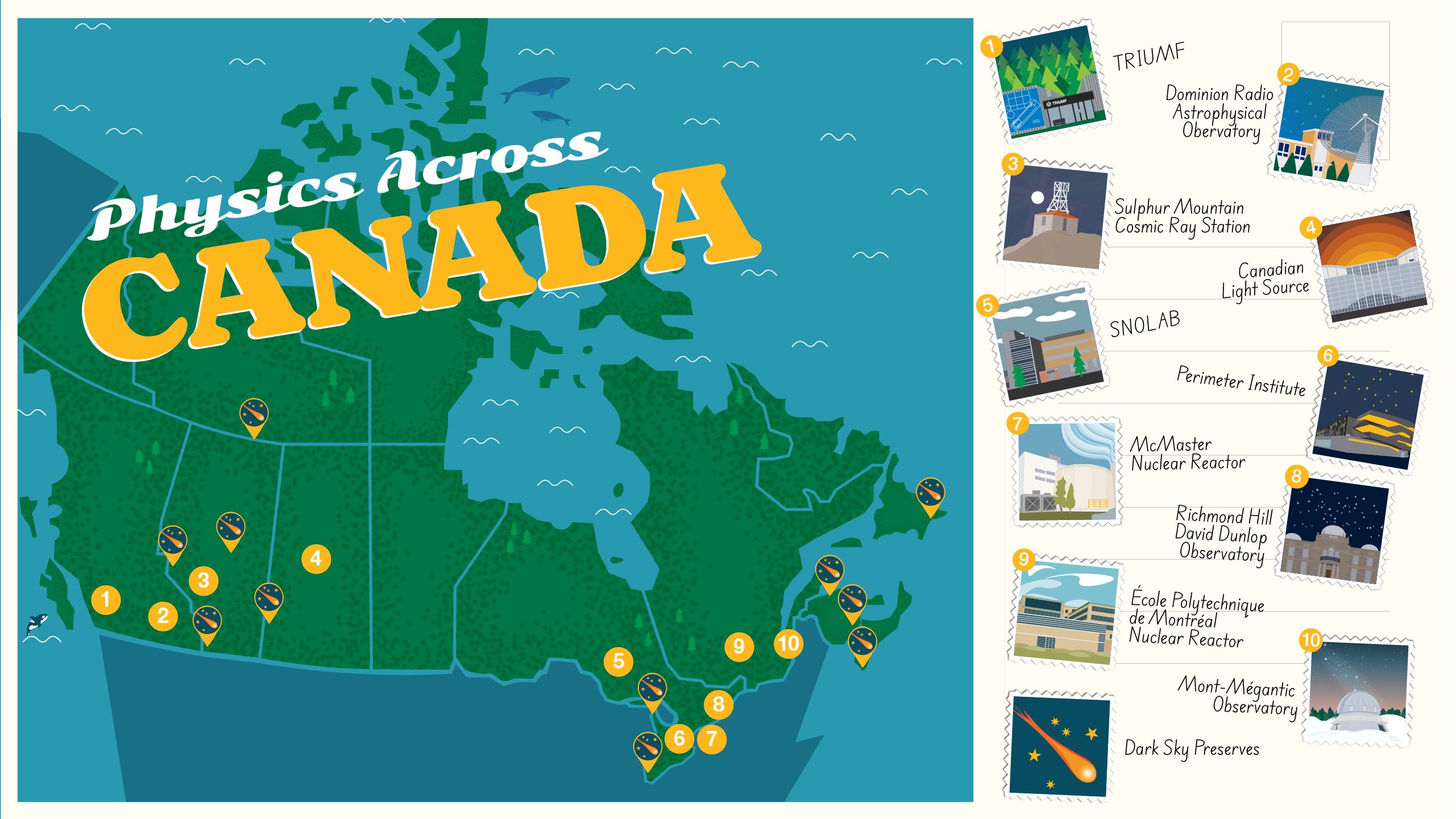Oh Canada! Did you know that the Great White North is home to important, groundbreaking physics research facilities? Let’s take a tour of 10 such spots that have contributed to physics research in Canada. And this is just the tip of the iceberg: universities, observatories, and community scientists across the country have helped deepen our understanding of the universe – there's lots to explore out there!
1. TRIUMF
Located in Vancouver, British Columbia, TRIUMF is home to a suite of experimental facilities, including one of the world’s largest cyclotrons. TRIUMF is on a quest to better understand the smallest particles in the universe, but they do more than smash particles together. Their research extends into fields like medicine, engineering, and technology development. The centre hosts thousands of visitors every year, including members of the public. Discover more here: https://triumf.ca/visit-us/.
2. Dominion Radio Astrophysical Observatory
Part of the Herzberg Astronomy and Astrophysics Research Centre, the Dominion Radio Astrophysical Observatory in Kaleden, British Columbia, maintains and operates four radio telescopes. It also hosts a variety of collaborative telescopes, including the Canadian Hydrogen Intensity Mapping Experiment (CHIME), Canada’s largest radio telescope (so far). Visitors can visit the observatory on public tours from April to October, 2025. Be prepared to go without your phone – all electronic devices must be turned off to protect sensitive research materials.
3. Sulphur Mountain Cosmic Ray Station
Sitting 2,283 metres above sea level, the Sulphur Mountain Cosmic Ray Station in Banff National Park, Alberta, was used to study cosmic radiation from outside our solar system. While the station closed in 1978, you can still visit the site. You have a choice in how to scale the mountain: either a ten-minute gondola ride or a two-to-three-hour hike.
4. Canadian Light Source
Operated by the University of Saskatchewan in Saskatoon, the Canadian Light Source is our country’s sole synchrotron, where extremely bright light is used to accelerate electrons to almost the speed of light. The synchrotron helps researchers investigate everything from fossils to batteries and more. The facility offers both in-person and virtual tours.
5. SNOLAB
Sometimes to study the night sky above us, you need to head underground. SNOLAB (Sudbury’s Neutrino Observatory LAB) is the world’s deepest clean lab, sitting two kilometres below the surface at the base of Vale’s Creighton mine near Sudbury, Ontario. Insulated from surface radiation, the facility specializes in detecting neutrinos from nearby supernovae and may help us detect dark matter. Take a virtual dive into the site here: https://www.snolab.ca/outreach/a-look-inside-snolab/.
6. Perimeter Institute (hey, that’s us!)
Perimeter Institute is a leading centre for research, training, and outreach in theoretical physics. Based in Waterloo, Ontario, we aim to deepen our understanding of the universe at its most fundamental level. Perimeter invites the public to join us on our exploration of the universe through public lectures and more. Check out the latest happenings here: https://perimeterinstitute.ca/outreach
7. McMaster Nuclear Reactor
McMaster University in Hamilton, Ontario is home to a research nuclear reactor that generates neutrons and iodine-25, a radioisotope used in treatment for prostate cancer. Take a virtual tour here: https://nuclear.mcmaster.ca/nuclear-operations-facilities/
8. Richmond Hill David Dunlop Observatory
Owned by the City of Richmond Hill, this observatory is home to the largest telescope in Canada. While no longer operational, the observatory provided evidence of Cygnus-XI being a black hole, among other achievements. Recognized as a national historic site, the observatory sits within the David Dunlop Observatory Park, surrounded by trails and greenspace.
9. École Polytechnique de Montréal Nuclear Reactor
École Polytechnique de Montréal, Québec, operates a SLOWPOKE-2 nuclear research reactor for both research and training. The reactor is often used for neutron activation analysis, a process which measures the concentrations of elements in samples and has applications in archaeology, medicine, and environmental studies.
10. Mont-Mégantic Observatory/Observatoire du Mont-Mégantic
A joint operation between Université de Montréal and the Université Laval, the Mont-Mégantic Observatory in Mont-Mégantic National Park, Québec, is a reflecting telescope that includes specializations to look outside our solar system and study exoplanets. Visitors can check out the AstroLab, the interpretive centre that coordinates tours and other outreach opportunities. Can’t make it in person? You can still catch a glimpse of the night sky through the observatory’s Catwalk Cameras.
Bonus: Dark-Sky Preserves
Parks Canada has designated 13 Dark-Sky Preserves across Canada. These protected areas aim to reduce or eliminate light pollution, making them great spots to set up a telescope and view the wonders of the universe. Wood Buffalo National Park takes the win for the largest Dark-Sky Preserve in the world.
About PI
Perimeter Institute is the world’s largest research hub devoted to theoretical physics. The independent Institute was founded in 1999 to foster breakthroughs in the fundamental understanding of our universe, from the smallest particles to the entire cosmos. Research at Perimeter is motivated by the understanding that fundamental science advances human knowledge and catalyzes innovation, and that today’s theoretical physics is tomorrow’s technology. Located in the Region of Waterloo, the not-for-profit Institute is a unique public-private endeavour, including the Governments of Ontario and Canada, that enables cutting-edge research, trains the next generation of scientific pioneers, and shares the power of physics through award-winning educational outreach and public engagement.












